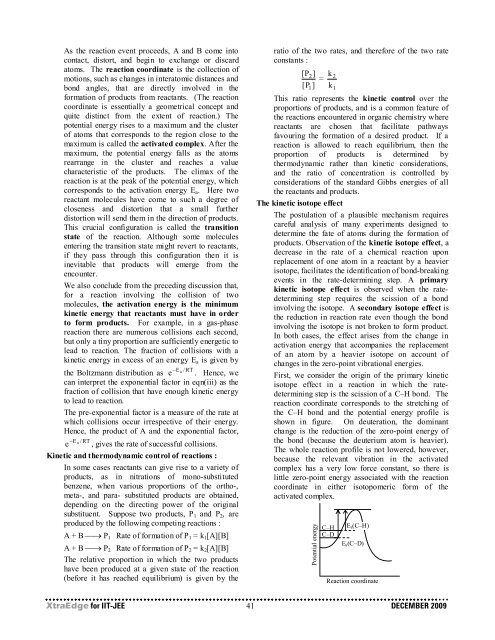Create successful ePaper yourself
Turn your PDF publications into a flip-book with our unique Google optimized e-Paper software.
As the reaction event proceeds, A and B come into<br />
contact, distort, and begin to exchange or discard<br />
atoms. The reaction coordinate is the collection of<br />
motions, such as changes in interatomic distances and<br />
bond angles, that are directly involved in the<br />
formation of products from reactants. (The reaction<br />
coordinate is essentially a geometrical concept and<br />
quite distinct from the extent of reaction.) The<br />
potential energy rises to a maximum and the cluster<br />
of atoms that corresponds to the region close to the<br />
maximum is called the activated complex. After the<br />
maximum, the potential energy falls as the atoms<br />
rearrange in the cluster and reaches a value<br />
characteristic of the products. The climax of the<br />
reaction is at the peak of the potential energy, which<br />
corresponds to the activation energy E a . Here two<br />
reactant molecules have come to such a degree of<br />
closeness and distortion that a small further<br />
distortion will send them in the direction of products.<br />
This crucial configuration is called the transition<br />
state of the reaction. Although some molecules<br />
entering the transition state might revert to reactants,<br />
if they pass through this configuration then it is<br />
inevitable that products will emerge from the<br />
encounter.<br />
We also conclude from the preceding discussion that,<br />
for a reaction involving the collision of two<br />
molecules, the activation energy is the minimum<br />
kinetic energy that reactants must have in order<br />
to form products. For example, in a gas-phase<br />
reaction there are numerous collisions each second,<br />
but only a tiny proportion are sufficiently energetic to<br />
lead to reaction. The fraction of collisions with a<br />
kinetic energy in excess of an energy E a is given by<br />
e −<br />
E a / RT<br />
the Boltzmann distribution as . Hence, we<br />
can interpret the exponential factor in eqn(iii) as the<br />
fraction of collision that have enough kinetic energy<br />
to lead to reaction.<br />
The pre-exponential factor is a measure of the rate at<br />
which collisions occur irrespective of their energy.<br />
Hence, the product of A and the exponential factor,<br />
E a / RT<br />
e − , gives the rate of successful collisions.<br />
Kinetic and thermodynamic control of reactions :<br />
In some cases reactants can give rise to a variety of<br />
products, as in nitrations of mono-substituted<br />
benzene, when various proportions of the ortho-,<br />
meta-, and para- substituted products are obtained,<br />
depending on the directing power of the original<br />
substituent. Suppose two products, P 1 and P 2 , are<br />
produced by the following competing reactions :<br />
A + B ⎯→ P 1 Rate of formation of P 1 = k 1 [A][B]<br />
A + B ⎯→ P 2 Rate of formation of P 2 = k 2 [A][B]<br />
The relative proportion in which the two products<br />
have been produced at a given state of the reaction<br />
(before it has reached equilibrium) is given by the<br />
ratio of the two rates, and therefore of the two rate<br />
constants :<br />
[P2]<br />
k 2<br />
=<br />
[P1<br />
] k1<br />
This ratio represents the kinetic control over the<br />
proportions of products, and is a common feature of<br />
the reactions encountered in organic chemistry where<br />
reactants are chosen that facilitate pathways<br />
favouring the formation of a desired product. If a<br />
reaction is allowed to reach equilibrium, then the<br />
proportion of products is determined by<br />
thermodynamic rather than kinetic considerations,<br />
and the ratio of concentration is controlled by<br />
considerations of the standard Gibbs energies of all<br />
the reactants and products.<br />
The kinetic isotope effect<br />
The postulation of a plausible mechanism requires<br />
careful analysis of many experiments designed to<br />
determine the fate of atoms during the formation of<br />
products. Observation of the kinetic isotope effect, a<br />
decrease in the rate of a chemical reaction upon<br />
replacement of one atom in a reactant by a heavier<br />
isotope, facilitates the identification of bond-breaking<br />
events in the rate-determining step. A primary<br />
kinetic isotope effect is observed when the ratedetermining<br />
step requires the scission of a bond<br />
involving the isotope. A secondary isotope effect is<br />
the reduction in reaction rate even though the bond<br />
involving the isotope is not broken to form product.<br />
In both cases, the effect arises from the change in<br />
activation energy that accompanies the replacement<br />
of an atom by a heavier isotope on account of<br />
changes in the zero-point vibrational energies.<br />
First, we consider the origin of the primary kinetic<br />
isotope effect in a reaction in which the ratedetermining<br />
step is the scission of a C–H bond. The<br />
reaction coordinate corresponds to the stretching of<br />
the C–H bond and the potential energy profile is<br />
shown in figure. On deuteration, the dominant<br />
change is the reduction of the zero-point energy of<br />
the bond (because the deuterium atom is heavier).<br />
The whole reaction profile is not lowered, however,<br />
because the relevant vibration in the activated<br />
complex has a very low force constant, so there is<br />
little zero-point energy associated with the reaction<br />
coordinate in either isotopomeric form of the<br />
activated complex.<br />
Potential energy<br />
C–H<br />
C–D<br />
E a (C–H)<br />
E a (C–D)<br />
Reaction coordinate<br />
XtraEdge for <strong>IIT</strong>-<strong>JEE</strong> 41 DECEMBER 2009

















